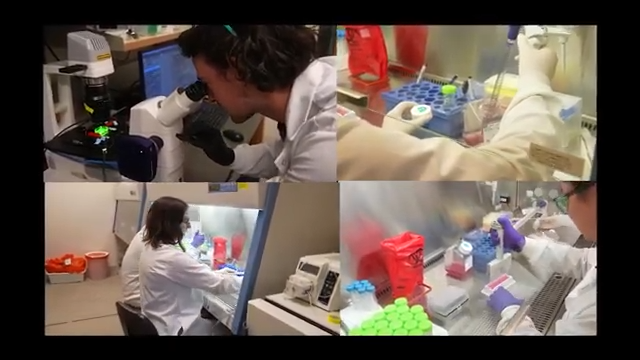CLEVELAND, Ohio (Ivanhoe Newswire) – Almost three and a half million people suffer from epilepsy – a disorder of the brain that can cause seizures. For some, these seizures can be controlled with medication, others will need brain surgery, which can be risky. But now, new technology is helping doctors pinpoint what’s causing the seizures better than ever before.
Gabriela “Gabi” Sable first started experiencing signs of epilepsy when she was just 11 – not long after, seizures started.
“People’s parents actually went to the school and told the school that they didn’t want me to hang out with their kids,” Gabi tells Ivanhoe.
Multiple hospitalizations and MRIs could not pinpoint what was causing the seizure.
Pediatric epileptologist at the Cleveland Clinic Epilepsy Center, Elia Pestan Knight, MD, says, “Some patients have very small malformations that we cannot see.”
Dr. Pestana Knight knew Gabi’s lesion was in her frontal lobe, but it was too tiny to know exactly where.
“We can, simply, not remove the whole frontal lobe. Those are her dominant lobes for her language and for her ability to write and comprehend the spoken language,” Dr. Pestana Knight explains.
The most common MRI used for diagnosis is something called the 3 Tesla – that’s the size of the magnet. But now, there’s a more powerful 7 Tesla MRI, which was able to determine exactly where Gabi’s lesion was.
Dr. Pestana Knight adds, “That lesion was far away from the areas of her speech.”
Dr. Pestana Knight was able to perform a robotic laser ablation therapy to remove the lesion, and now, Gabi is seizure-free and doing all the things she was never able to do before, including hiking Peru’s Machu Picchu.
Gabi was part of a clinical trial on the 7 Tesla MRI. It has now been approved by the FDA and is expected to help hundreds of thousands of people suffering with hard to detect lesions that cause epilepsy.
Contributors to this news report include: Marsha Lewis, Producer; Kirk Manson, Videographer; Roque Correa, Editor.
To receive a free weekly e-mail on medical breakthroughs from Ivanhoe, sign up at: http://www.ivanhoe.com/ftk
Source:
https://www.cdc.gov/epilepsy/about/fast-facts.htm
MEDICAL BREAKTHROUGHS
RESEARCH SUMMARY
TOPIC: TESLA TARGETS EPILEPSY
REPORT: MB #5305
BACKGROUND: Epilepsy is a neurological disorder marked by recurrent seizures, which are episodes of abnormal electrical activity in the brain. These seizures can manifest in various ways, including convulsions, loss of consciousness, repetitive movements, and sensory disturbances. The triggers for epilepsy can be diverse, ranging from genetic factors and brain injuries to infections or tumors. Diagnosing epilepsy involves a thorough examination of an individual’s medical history, detailed observation of seizure characteristics, and various diagnostic tests, such as EEGs and advanced imaging techniques like MRI, to identify underlying causes and determine the most effective treatment approach.
DIAGNOSING: Common treatments for epilepsy include a range of antiepileptic medications to control seizures. These medications aim to stabilize electrical activity in the brain and prevent the occurrence of seizures. In cases where medications are ineffective, alternative treatments may include dietary therapies like the ketogenic diet or surgical interventions to remove or disconnect the specific area of the brain responsible for seizures. Additionally, neuromodulation devices, such as vagus nerve stimulators, can be used to help manage epilepsy symptoms.
(Source:
https://www.nhs.uk/conditions/epilepsy/treatment/)
NEW TECHNOLOGY: The seven Tesla MRI operates at a higher magnetic field strength than traditional MRIs, and has emerged as a valuable tool in epilepsy diagnosis and treatment planning. This advanced imaging technology provides enhanced resolution and detailed visualization of brain structures, aiding healthcare professionals in identifying abnormalities associated with epilepsy. Specific features, such as hippocampal sclerosis or structural lesions, become more evident with the use of seven Tesla MRI, allowing for more precise localization of seizure patterns and tailoring personal treatment strategies. The 7 Tesla MRI stands out from the more common 3 Tesla and standard MRI machines, due to its higher magnetic field strength. The strength of the magnetic field influences the quality and resolution of the images produced. In comparison to the 3 Tesla MRI, the 7 Tesla MRI provides significantly enhanced spatial resolution, offering finer details of brain structures. This magnified resolution is particularly beneficial in epilepsy cases, where precise localization of abnormalities such as subtle lesions or changes in the hippocampus is crucial for accurate diagnosis and treatment planning.
FOR MORE INFORMATION ON THIS REPORT, PLEASE CONTACT:
Alicia Reale Cooney
If this story or any other Ivanhoe story has impacted your life or prompted you or someone you know to seek or change treatments, please let us know by contacting Marjorie Bekaert Thomas at mthomas@ivanhoe.com




